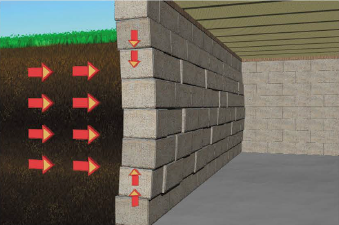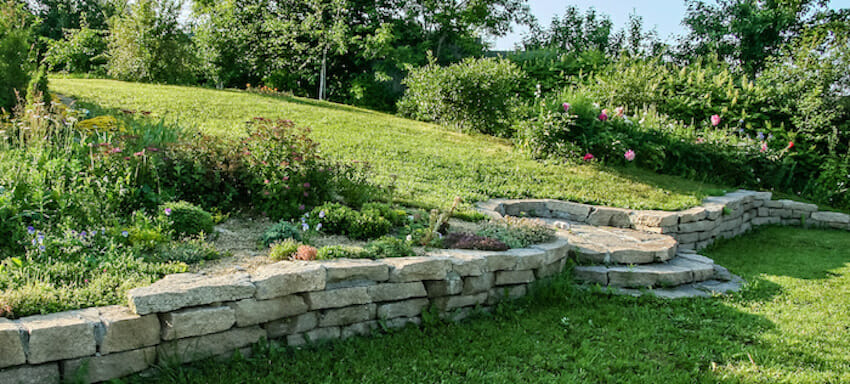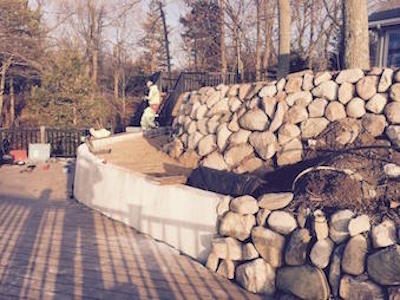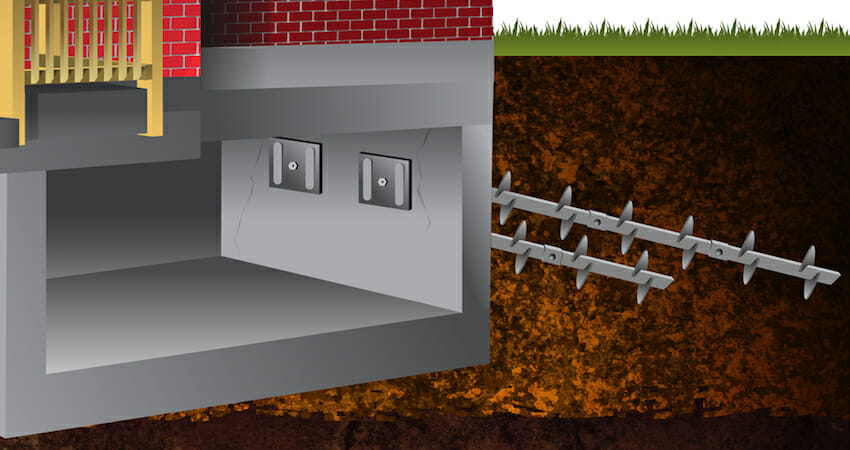With the winter season coming soon, you may notice that your basement walls are looking a little…close. Are the walls closing in on you? Bowing and leaning walls in a basement are no joke. They can cause serious damage to your home and foundation if they are not repaired correctly.
The Cause Of Bowing Basement Walls

With all these factors in play, how does one go about getting this issue fixed?
Have you noticed buckling, moving, leaning, or shifting?
If you notice that your basement walls are leaning in, you should have a foundation repair company assess the situation and see if helical tiebacks are necessary. In cases of lateral or horizontal foundation movement, helical tiebacks are used to strengthen foundation walls and prevent further shifting. The strength and stability of helical tiebacks are maximized by installing them horizontally and angled downward, which allows a greater torque. Steel plates are fastened to the inside of the wall to ensure reinforcement and stability of the wall. This creates “pull” to counterbalance the push from the surrounding soil. The surrounding soil acts as an anchor, creating resistance to a shifting foundation, and reducing wall destabilization.
Diagnosing Your Problem
Basement walls are one of the most common areas in need of tiebacks. The surrounding soil constantly pushes against the basement walls, giving them a tendency to lean inward. Combine that with the possibility of soil expansion, shifts caused by rain or water, and freezing ground. Suddenly you have more factors contributing to the declining integrity of your basement walls.
First, the foundation repair company will identify the condition of your walls and what is causing them to lean. Pressure from the surrounding soil is only one of the potential problems. Perhaps there are tree roots starting to invade and push the wall inward. If that’s the case, you may want to consider removing the tree. If surrounding soil is the main issue, tiebacks may be needed.
Next, we need to consider the condition of the walls. Are there cracks? How was the wall constructed? What is it made of? Once the situation is assessed, a repair solution can be chosen. Options include jacking up the house, removing and replacing the wall, or securing the wall with helical tieback anchors.
Helical tiebacks work well in situations involving bowing basement walls. The tiebacks not only provide support; the additional outward pull is what makes helical tiebacks an optimal solution. To ensure that the basement walls will be pulled outward, the surrounding soil is removed during the helical tieback process. Once the soil is removed and the helical tiebacks are set, the anchors will began to pull back and correct the basement walls.
Retaining Wall Repair With Helical Tiebacks
Helical tiebacks are also useful if you have retaining or seawalls on lakefront property. Retaining walls have many purposes. Some may be decorative, some may be functional, and some may be a combination of both. Generally, retaining walls are used to hold back sloped soil and allow a flat soil surface where none previously existed. The newly created flat surface above the wall can be used for gardening, outdoor recreation, and a variety of other purposes. Whatever the use, it is important for retaining walls to remain stable and secure.
Retaining walls come in all shapes and sizes. We have seen variations ranging from poured concrete and masoned stone, to wooden planks and sheet metal. Ultimately, the common factor that all of these walls share is that they are stabilized by gravity. But because of the immense lateral pressure that these walls hold back, that stabilization can quickly diminish. Adding a helical tieback can help to add support and relieve some of the pressure that retaining walls face.

Retaining walls have a tendency to move, shift, or ultimately fail. Retaining walls can fail for a number of reasons. If your retaining walls were reinforced in the incorrect position, either by construction area, size, or location, they can cause you more problems in the future.
Saturated backfill can also cause problems, especially if there is pooling water or expansive pressure behind the walls. Perhaps the weep/drainage holes in the retaining walls have become blocked over time. Other potential problems include design errors, installation errors, and foundation problems. Helical tiebacks can help keep your retaining walls in place.
Even with such a unique retaining wall, helical tiebacks can still be used.
Does Your Retaining Wall Need Repair?
How do you know if your retaining wall is facing problems? One of the easiest and most visible indicators is cracks in the wall itself. A crack in concrete is always an easy-to-spot indicator of a failing retaining wall. The same applies to brick and masoned stone; a stair-stepping pattern of cracks will start to appear. If your retaining wall is made of wood, look for bulging or splinters.
Using a level to test the angle of your wall is an often overlooked indicator of a retaining wall in need of repair. A level will help you determine if the wall has sunken or moved. Gaps in the soil around the wall, soil spilling over the edge, or cracks and splinters are indicators that your retaining wall is failing.
Retaining Wall Repair In Hudsonville, Michigan
Our team at Kent Foundation Repair recently repaired a retaining wall in Hudsonville, Michigan. The owners noticed their retaining wall was starting to slide and requested that Kent Foundation Repair correct the situation. After accessing the retaining wall, we found that the best procedure was to install two helical tiebacks to help secure the wall to more competent soils. We were able to repair the retaining wall in a few hours and have it ready for the Spring season. It is important to keep retaining walls from leaning in. They can help to keep certain soils and even water from entering different parts of your property.
Retaining Wall Repair In South Haven, Michigan


We also repaired a large, multi-tiered retaining wall in South Haven, Michigan. The retaining wall was attached to a deck that overlooks Lake Michigan. It was also unique in its composition: large stone boulders. Our team was able to disassemble the retaining wall and install helical tiebacks. We then backfilled the excavated ground and placed the boulders from the retaining wall back in their proper place. Even with such a unique retaining wall, helical tiebacks can still be used.
Bowing Basement Walls: A Problem That Should Not Be Ignored
So ask yourself: “Are the walls closing in?” Have you noticed buckling, moving, leaning, or shifting? Have you noticed one or many of the indicators of a failing wall? If so, helical tiebacks may be the answer for you. Be sure to contact a home repair company you trust to have your wall repaired correctly and efficiently. The integrity of your home may be at stake.


